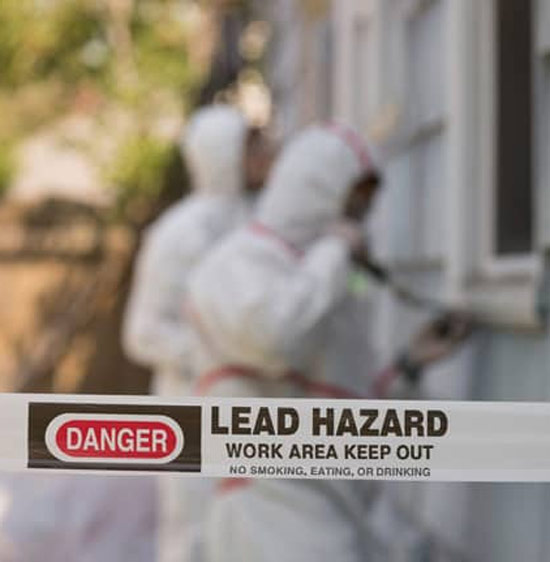Lead Paint Removal Service-- NYC's Trusted Solutions for Lead Security
Lead Paint Removal Service-- NYC's Trusted Solutions for Lead Security
Blog Article
Important Tools and Techniques for Effective Lead Violation Cleanup
Addressing lead infractions successfully necessitates a thorough method that blends the right devices with strategic techniques. Concurrently, the use of specialized cleanup devices, such as HEPA vacuum cleaners and lead-specific cleansing agents, is imperative for comprehensive impurity elimination. Efficient control approaches, including plastic sheet and negative air pressure systems, are crucial to avoid the spread of dangerous products.
Individual Safety Devices
Personal protective devices (PPE) is an important part in the effective administration of lead contamination cleanup. PPE works as a vital barrier, protecting workers from the unsafe impacts of lead exposure, which can result in severe wellness repercussions. The vital PPE for lead clean-up includes respirators, safety clothing, handwear covers, and eye protection. Each sort of devices is specifically designed to mitigate various risks connected with lead bits and dust.
Respirators, particularly those equipped with HEPA filters, are indispensable for filtering system air-borne lead bits, protecting against inhalation. Protective clothes, consisting of coveralls and disposable matches, stops lead dirt from adhering to employees' garments, reducing the danger of additional contamination.
Furthermore, extensive training on the correct use and upkeep of PPE is crucial. Workers should be informed on wearing and doffing procedures to prevent contamination. Normal examinations and substitutes of PPE parts are required to maintain their protective capacities, guaranteeing a secure and compliant cleanup operation.
Specialized Cleaning Equipment

An additional important tool is the wet/dry vacuum, which can effectively tidy up both dust and fluid contaminants. These vacuum cleaners often feature HEPA filters to give an added layer of safety. Wet wipes or tack cloths are also critical for surface cleansing; they are especially made to catch and hold lead bits, minimizing the danger of spreading out contamination.
For even more persistent deposits, specialized lead-removal cleaning agents are required. These agents are developed to break down lead fragments, making them much easier to get rid of. Scrub brushes with strong bristles can help in this process, especially on harsh surfaces where lead dust often tends to adhere a lot more highly.
Additionally, encapsulants are used to secure lead-contaminated surface areas, stopping the launch of lead dirt. These specialized paints and coatings are made to stick to various substrates, offering a long-lasting remedy for lead containment.
Efficient Control Approaches
Efficient control techniques are essential in reducing the spread of lead contamination throughout cleanup activities. Implementing durable control methods makes certain that lead bits do not migrate to untouched locations, consequently securing both employees and the atmosphere. One key method is making use of plastic sheeting to secure off contaminated areas. Durable polyethylene obstacles can be installed from flooring to ceiling to develop a regulated work location, considerably lowering the threat of airborne lead dust dispersal.

To enhance containment, encapsulants can be related to surfaces that are not being eliminated or interrupted. These specialized coatings bind lead dust, reducing its schedule for resuspension. In addition, all personnel have to put go to this web-site on proper Personal Safety Equipment (PPE), including respirators and disposable suits, to avoid contamination spread.
Safe Disposal Practices
Making sure risk-free disposal methods is an essential part in the administration of lead contamination clean-up. Correct disposal alleviates the threat of lead important site re-entering the setting and jeopardizing public wellness (DOH & HPD Lead Violation Removal NYC).
Transferring lead waste calls for adherence to stringent standards. Utilizing certified harmful waste service providers guarantees that the materials are handled properly. Documents, including materializes outlining the type and quantity of waste, ought to accompany deliveries to track the waste from the site of origin to its final disposal destination.
Designated contaminated materials disposal centers are equipped to manage lead-contaminated products safely. These facilities usually employ innovative approaches such as stablizing, solidification, or chemical treatment to reduce the effects of the lead before disposal. Landfilling in specialized, lined areas that avoid leachate from polluting groundwater is a common method for last disposal.
Normal training for personnel entailed in lead waste disposal is critical to preserve safety and security standards and stop unexpected direct exposure. By sticking to these practices, organizations can substantially reduce the environmental and wellness influences connected with lead contamination.
Regulatory Compliance Tips

Following regulative conformity is critical in the successful execution of lead contamination clean-up. Understanding and following federal, state, and regional laws guarantees not just the safety and security and wellness of individuals but additionally the legal and monetary health of the cleaning company. The Environmental Defense Agency (EPA) sets rigorous criteria, such as the Lead Improvement, Fixing, and Paint (RRP) Policy, which mandates proper accreditation and training for specialists managing lead-based activities.
Compliance starts with a detailed assessment of applicable legislations and regulations. Organizations must remain updated on any type of legislative changes, which can be facilitated via normal training sessions and registering for industry updates. Documents is an additional vital conformity aspect; preserving thorough documents of all activities, consisting of inspection reports, staff member training logs, and disposal shows up, is important.
In addition, engaging with certified lead assessors or run the risk of assessors ensures that lead risks are appropriately identified and minimized. Companies must implement the use of Individual Protective Equipment (PPE) and ensure that security procedures are that site strictly adhered to. Lastly, clear interaction with stakeholders, including employees, customers, and regulative bodies, will certainly cultivate a society of conformity and liability, eventually adding to a much safer and more efficient lead cleaning process.
Verdict
Effective lead infraction cleaning requires the integration of specialized tools and calculated methodologies to make sure safety and security and effectiveness. Utilizing HEPA vacuums, specialized cleaning agents, and effective control methods such as plastic sheeting and adverse atmospheric pressure systems is vital. Individual safety tools (PPE) safeguards workers from exposure, while risk-free disposal methods and stringent adherence to regulatory conformity are necessary for properly taking care of contaminated materials. Jointly, these procedures substantially minimize health threats and add to a cleaner environment.
Report this page